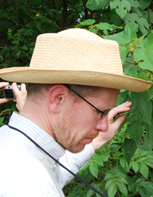Richard Telford’s Blog
 @richardjtelford
@richardjtelford
Recent Comments
-
Recent Posts
- Resampling Assemblage Counts
- A demo targets plan for reproducible pipelines for Neotoma data
- Reproducibility of high resolution reconstruction – one year on
- Simplistic and Dangerous Models
- COVID-19, climate and the plague of preprints
- Erroneous information … was given
- Making a pollen diagram from Neotoma
Archives
Categories
Tags
- analogue quality
- autocorrelation
- Baffin Island
- Barycentre
- Benthic foraminifera
- Bob Irvine
- Bulafu et al (2013)
- calibration-in-time
- China
- chironomids
- chrysophytes
- climate models
- critical transition
- data archiving
- diatoms
- Dietl (2016)
- dinocysts
- Doug Keenan
- EDA
- graphics
- Guiot and de Vernal (2011)
- h-block cross-validation
- Heartland
- impact
- INTIMATE training school
- Kelsey et al 2015
- Klein et al (2013)
- Klemm et al 2013
- lake level
- Lake Silvaplana
- Larocque-Tobler et al (2010)
- Larocque-Tobler et al (2011)
- Larocque-Tobler et al (2012)
- Larocque-Tobler et al (2015)
- LGM
- Liu et al 2014
- Lyons et al 2016
- maps
- Marcott et al 2013
- Mauri et al (2015)
- Miller et al 2013
- moss
- Murry Salby
- neotoma
- NIPCC
- Norway
- ocean acidification
- ordination
- palaeoSig
- Peer review
- Planktonic foraminifera
- Poland
- pollen
- R
- radiocarbon calibration
- radiocarbon dating
- Reconstruction diagnostics
- reconstructions
- REDFIT
- Schulz & Mudelsee (2002)
- Sea ice
- sea ice reconstruction
- Skjærvø et al (2015)
- spatial autocorrelation
- Spectral analysis
- Tatra Mountains
- Telford (2006)
- Telford and Birks (2011)
- Testate amoeba
- Transfer function diagnostics
- Uganda
- uneven sampling
- Willie Soon
- Younger Dryas
- Zhang et al 2017
Blogroll
Follow me on Twitter
My TweetsMeta
- Follow Musings on Quantitative Palaeoecology on WordPress.com
Category Archives: R
Resampling Assemblage Counts
Imagine that one diatom assemblage has 20 species and another has 25, but the more species rich assemblage also has more diatoms counted.A fair comparison of the richness of each assemblage can only be made when the number of individuals … Continue reading
Making a pollen diagram from Neotoma
Last week I gave a course on R for palaeoecologists covering data handling using tidyverse, reproducibility and some some ordinations and transfer functions. One of the exercises was to download some pollen data from Neotoma and make a pollen diagram. … Continue reading
Funky ordination plots with ggvegan
Yesterday, I tweeted a photo of a ordination I plotted with ggvegan, and thought I should show how I made it. ggvegan and ggplot make it easy to make complex ordination plots pic.twitter.com/zmEal7W4Q8 — Richard Telford (@richardjtelford) April 10, 2019 … Continue reading
Introducing ggpalaeo
I’ve put some code I used for plotting figures for my soon-to-be-resubmitted manuscript into a package because I thought it might be useful to others. The main use of ggpalaeo is to make ggplot2 plots of transfer function diagnostics from … Continue reading
The elevation of Lake Tilo
For my PhD, I studied the palaeolimnology of two lakes in the Ethiopian rift valley, using diatoms to reconstruct changes in the water chemistry of Lake Awassa, an oligosaline caldera lake which retains its low salinity despite having no effluent … Continue reading
Posted in Data manipulation, Palaeohydrology, R, Uncategorized
Tagged lake level, Lake Tilo, Telford and Lamb (1999)
Leave a comment
Insist() on the text and numbers agree in Rmarkdown
The manuscript I submitted a long time ago contains multiple sentences where I describe the result with both text and numbers. For example: With a three-year moving average, the correlation is weak (r = 0.21) and not statistically significant (p … Continue reading
Citing R and packages automatically
Almost every manuscript I write has a paragraph that looks something like this: All analyses were done in R version 3.4.4 (R Core Team 2017). Ordinations were fitted with vegan version 2.4-6 (Oksanen et al. 2017) with square-root transformed assemblage … Continue reading
Merging taxa in assemblage data
One possible reason for the impossible percent values I’ve found in assemblages data is that taxa have been merged in Excel after percent were calculated. Doing anything in Excel is to invite disaster, if nothing else, it is very difficult … Continue reading
Posted in Data manipulation, R
Leave a comment
Extracting data from a PDF image
Some scientists archive their data. Some scientists email their data on request. Some editors cajole authors into releasing data to interested parties. And sometimes none of these approaches yields data. What then? One option is to request data via the … Continue reading
Posted in Peer reviewed literature, R
Tagged chironomids, data scraping, Luoto and Ojala (2017), pdf
2 Comments
Bergen: a year with some sunshine
May was glorious. December less so. The data are from the Geofysisk Institutt in Bergen. Here is the code I used
